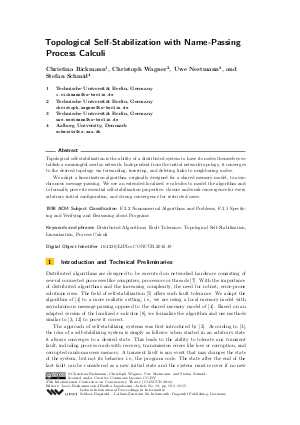Topological Self-Stabilization with Name-Passing Process Calculi
Authors Christina Rickmann, Christoph Wagner, Uwe Nestmann, Stefan Schmid
-
Part of:
Volume:
27th International Conference on Concurrency Theory (CONCUR 2016)
Part of: Series: Leibniz International Proceedings in Informatics (LIPIcs)
Part of: Conference: International Conference on Concurrency Theory (CONCUR) - License:
 Creative Commons Attribution 3.0 Unported license
Creative Commons Attribution 3.0 Unported license
- Publication Date: 2016-08-24
File

PDF
LIPIcs.CONCUR.2016.19.pdf
- Filesize: 0.6 MB
- 15 pages
Document Identifiers
Subject Classification
Keywords
- Distributed Algorithms
- Fault Tolerance
- Topological Self-Stabilization
- Linearization
- Process Calculi
Metrics
- Access Statistics
-
Total Accesses (updated on a weekly basis)
0Document
0Metadata
Abstract
Topological self-stabilization is the ability of a distributed system to have its nodes themselves establish a meaningful overlay network. Independent from the initial network topology, it converges to the desired topology via forwarding, inserting, and deleting links to neighboring nodes. We adapt a linearization algorithm, originally designed for a shared memory model, to asynchronous message-passing. We use an extended localized pi-calculus to model the algorithm and to formally prove its essential self-stabilization properties: closure and weak convergence for every arbitrary initial configuration, and strong convergence for restricted cases.
Cite As Get BibTex
Christina Rickmann, Christoph Wagner, Uwe Nestmann, and Stefan Schmid. Topological Self-Stabilization with Name-Passing Process Calculi. In 27th International Conference on Concurrency Theory (CONCUR 2016). Leibniz International Proceedings in Informatics (LIPIcs), Volume 59, pp. 19:1-19:15, Schloss Dagstuhl – Leibniz-Zentrum für Informatik (2016)
https://doi.org/10.4230/LIPIcs.CONCUR.2016.19
BibTex
@InProceedings{rickmann_et_al:LIPIcs.CONCUR.2016.19,
author = {Rickmann, Christina and Wagner, Christoph and Nestmann, Uwe and Schmid, Stefan},
title = {{Topological Self-Stabilization with Name-Passing Process Calculi}},
booktitle = {27th International Conference on Concurrency Theory (CONCUR 2016)},
pages = {19:1--19:15},
series = {Leibniz International Proceedings in Informatics (LIPIcs)},
ISBN = {978-3-95977-017-0},
ISSN = {1868-8969},
year = {2016},
volume = {59},
editor = {Desharnais, Jos\'{e}e and Jagadeesan, Radha},
publisher = {Schloss Dagstuhl -- Leibniz-Zentrum f{\"u}r Informatik},
address = {Dagstuhl, Germany},
URL = {https://drops.dagstuhl.de/entities/document/10.4230/LIPIcs.CONCUR.2016.19},
URN = {urn:nbn:de:0030-drops-61761},
doi = {10.4230/LIPIcs.CONCUR.2016.19},
annote = {Keywords: Distributed Algorithms, Fault Tolerance, Topological Self-Stabilization, Linearization, Process Calculi}
}
Author Details
References
-
P.-D. Brodmann. Distributability of Asynchronous Process Calculi. Master’s thesis, Technische Universität Berlin, Germany, October 2014.

-
E. W. Dijkstra. Self-stabilizing Systems in Spite of Distributed Control. Communications of the ACM, 17(11):643-644, November 1974.

-
S. Dolev. Self-Stabilization. The MIT Press, 2000.

-
D. Gall et al. A Note on the Parallel Runtime of Self-Stabilizing Graph Linearization. Theory of Computing Systems, 55(1):110-135, 2014.

-
F. C. Gärtner. Fundamentals of Fault-tolerant Distributed Computing in Asynchronous Environments. ACM Comput. Surv., 31(1):1-26, March 1999.

-
M. G. Gouda. The Triumph and Tribulation of System Stabilization. In Proc. of the 9th International WDAG, WDAG '95, pages 1-18, 1995.

-
N. A. Lynch. Distributed Algorithms. Morgan Kaufmann Publishers Inc., 1996.

-
M. Merro and D. Sangiorgi. On Asynchrony in Name-Passing Calculi. In Proc. of ICALP, volume 1443 of LNCS, pages 856-867. Springer, 1998.

-
R. Milner. communicating and mobile systems: the pi-calculus. Cambridge UP, 1999.

-
C. Rickmann. Topological Self-Stabilization with Name-Passing Process Calculi. Master’s thesis, Technische Universität Berlin, Germany, October 2015. arxiv.org/abs/1604.04197.

-
D. Sangiorgi and D. Walker. The π-calculus: A Theory of Mobile Processes. Cambridge UP, 2001.

-
C. Wagner and U. Nestmann. States in Process Calculi. In Proc. of EXPRESS/SOS, volume 160 of EPTCS, pages 48-62, 2014.

